Shabby Homes, Rising Debts: The Trouble With PM’s Rural Housing Fund
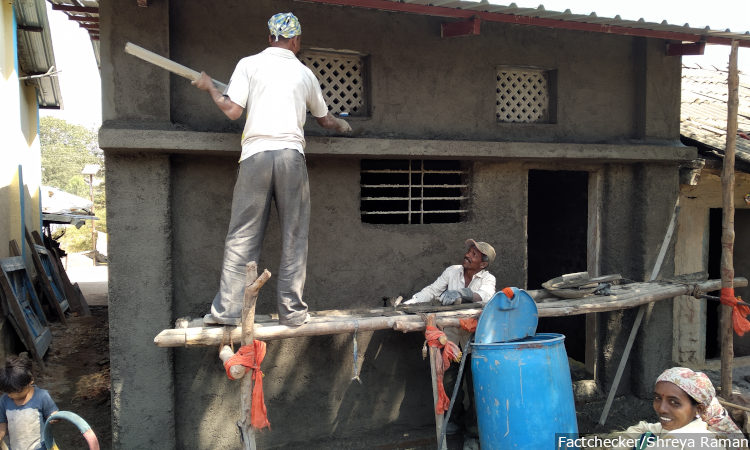
A house being constructed under the Pradhan Mantri Awaas Yojana in Pimplad village in Maharashtra’s Nashik district.
Nashik (Maharashtra): Till August 2017, Namdev Lilake, 74, and his family of 13 lived in what is commonly described in India as a kutcha house--made with mud and thatch--in Kochargaon village in western Maharashtra’s Nashik district. Then, Lilake was named a beneficiary of a government programme that helps poor and socially backward Indians upgrade their homes.
The Pradhan Mantri Awaas Yojana- Gramin (PMAY-G; prime minister’s housing scheme - rural) launched in 2016 by Prime Minister Narendra Modi, offers beneficiaries Rs 120,000 to either tear down a kutcha home and build a permanent structure in its place or build a pucca house--a permanent, cemented structure--afresh. The programme aims to provide housing for all Indians by building 29.5 million houses by 2022.
Lilake took eight months to “upgrade” his home using PMAY-G funds, and in May 2018, an assistant engineer and a rural housing engineer came to inspect it. They photographed the house and uploaded the images onto AwaasSoft, an e-governance platform.
The government team declared the house complete and fit to inhabit.
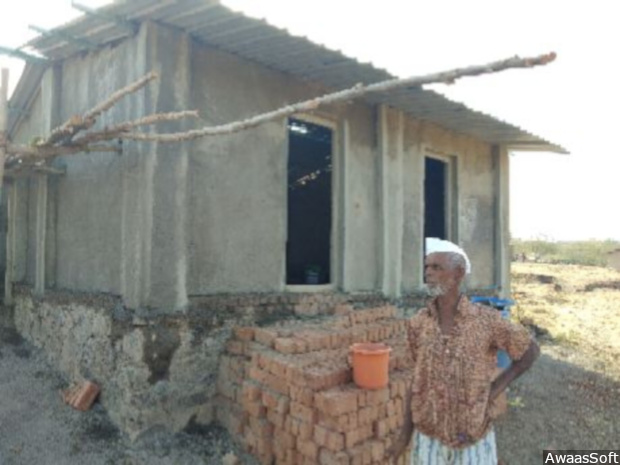
Namdev Lilake outside his ‘completed’ house on May 14, 2018. This image was uploaded on the scheme’s e-governance portal AwaasSoft. The house is visibly incomplete with the cement falling apart at the base.
When we visited Lilake’s home, 10 months after it was certified, it was incomplete and uninhabitable. Chunks of cement appeared to have fallen off the base of the house, the roof was not cemented and covered with asbestos sheets, the walls were unfinished, and the floor was covered in sand and cement.
So, Lilake and his family continue to live in their old kutcha house.
Lilake told us he received only Rs 85,000 in three installments--two of Rs 30,000 and one of Rs 25,000--so he had to borrow Rs 35,000 from his relatives to finish the work. But AwaasSoft states that Lilake has received Rs 120,000 in five installments, the last one on August 2, 2018.
Lilake’s two sons are daily wage labourers and, in the lean season, they find work only for three to four days a month at Rs 200 per day. The family’s farm is barren. With few livelihood options, Lilake was worried about repaying the debt. He refused to borrow any more money.
In Kochargaon village, 134 households have been named PMAY-G beneficiaries since 2014-15. Of them, 110 have been verified, village development officer PV Gaikwad told FactChecker.
However, in our travels through Kochargaon, we found that most of these “completed” houses were not much better than kutcha ones. Like the Lilakes, none of the families we spoke to had moved into their new homes. A few who had moved, lived in homes that were barely inhabitable.
The instalment system had led many beneficiaries to debts, FactChecker found.
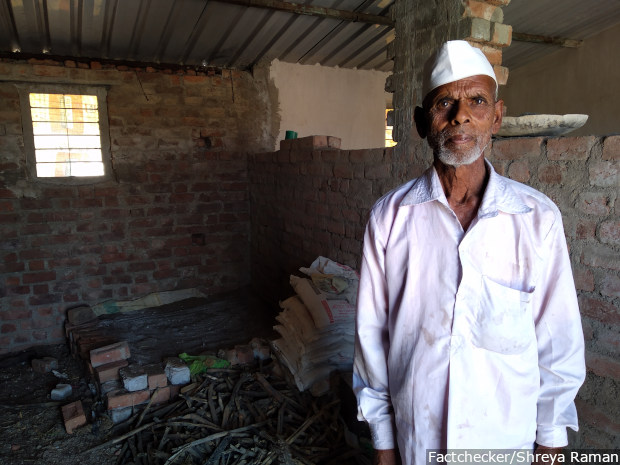
Namdev Lilake, 74, inside the house constructed under PMAY-G, the Prime Minister’s rural housing programme. Declared “complete” in May 2018, it is uninhabitable.
In May 2014, the newly elected National Democratic Alliance government had promised a pucca house for every family by 2022. The target was to build 10 million houses by March 31, 2019. As of April 15, 2019, the government has constructed 7.7 million houses, 77% of the target, FactChecker reported on April 23, 2019.
This story continues a FactChecker series evaluating the government’s flagship programmes against the backdrop of the ongoing 2019 general elections.
The first of this series investigated the government’s rural-jobs programme (here, here and here); the second discussed the Swachh Bharat (Clean India) Mission’s sewage problem; the third (here, here and here) evaluated the Pradhan Mantri Sahaj Bijli Har Ghar Yojana (Prime Minister’s electricity-to-all-homes programme); the fourth, the fudging of open-defecation-free (ODF) status data and shoddy toilet construction–amid evident enthusiasm and success in increasing toilet access–in Uttar Pradesh, declared ODF on December 31, 2018; the fifth, similar fudging of data and widespread open defecation in Gujarat, declared ODF on October 2, 2017; the sixth explaining how the skills-development mission was set to miss deadlines; the seventh probing the failures of the Prime Minister’s crop-insurance programme; the eighth on the PM’s failed promise of bringing broadband connectivity to every Indian village; the ninth on why the Namami Gange project to clean up the Ganga river is failing; the 10th on how the cooking-gas programme is welcome but too expensive; and the 11th found that the PM’s urban housing programme was half-finished and behind schedule.
Changing face of rural housing
Rural housing as an independent programme--it was earlier clubbed with social upliftment programmes--started in 1996 in India with the Indira Awaas Yojana (IAY). In 2014, the Comptroller and Auditor General (CAG) released a report highlighting its shortcomings. The scheme had failed to identify deserving beneficiaries, ensure that the quality of the structures was good or facilitate the convergence of the scheme with the other public projects.
Addressing these shortcomings, the Bharatiya Janata Party (BJP)-led NDA government restructured IAY into PMAY-G. The new scheme increased financial assistance from Rs 70,000 to Rs 120,000 for building houses in the plains and from Rs 75,000 to Rs 130,000 for those in hilly areas.
Under IAY, the beneficiaries were selected from below poverty line households. Under PMAY-G the beneficiaries were selected as per the housing deprivation parameters of the Socio Economic Caste Census, 2011 (SECC).
Also, PMAY-G attempts to converge various government schemes such as Mahatma Gandhi National Rural Employment Guarantee Scheme (MGNREGS), Swachh Bharat Mission - Gramin (Clean India Mission - Rural) and Pradhan Mantri Ujjwala Yojana (prime minister’s clean fuel programme).
In addition to the financial assistance, the beneficiary is entitled to 90 “persondays” of unskilled labour (95 in the case of northeast states and hilly areas) for construction under the government’s rural jobs programme, MGNREGS, which amounts to around Rs 18,000. Beneficiaries eligible for assistance to build toilets under the government’s sanitation programme, the Swachh Bharat Mission, are also given Rs 12,000.
The assistance to the beneficiaries is transferred based on the progress of the construction through a minimum of three instalments. In Maharashtra, the amount is transferred in five instalments:
- Rs 25,000 within a week of the sanction order
- Rs 30,000 after the house is constructed upto the base or plinth level
- Rs 30,000 after the house is constructed upto the lintel level, that is after the outer walls are built
- Rs 25,000 after the roof is cast
- Rs 10,000 + Rs 18,000 under MGNREGS + Rs 12,000 under SBM (if applicable) after the house is complete
Rising debts, shoddy construction
The Rs 120,000 offered under the scheme is simply not enough to construct a house, said Tukaram Gangurde, a mason from Pimplad village in Nashik. “You need at least Rs 200,000 to build a house,” he said. “With Rs 120,000, we can construct up to the plinth level, that too with substandard raw material.”
In Kochargaon village, Sugandha Tongare, 22, and her family have taken a loan of Rs 20,000 to finish their house. Tongare’s husband was named a beneficiary in November 2018. Since then, the family has received Rs 55,000 in two installments. The couple has finished constructing the foundation and the walls and also cast the roof, but the inside of the house is still incomplete.
“We have taken around Rs 20,000 as loan from our relatives and we bought the bricks for the house on loan,” Tongare told FactChecker. “I hope we get the rest of the money soon.”
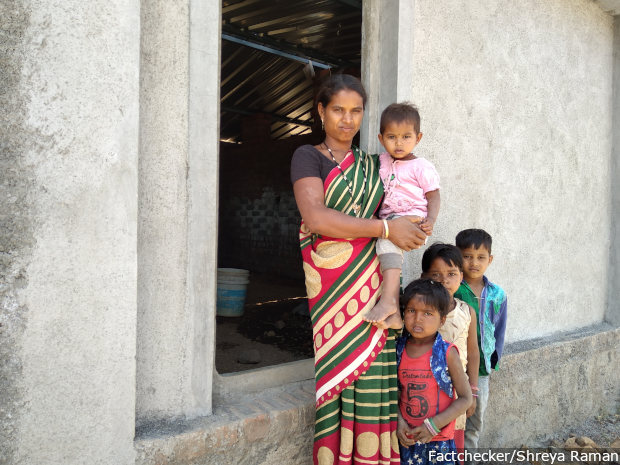
Sugandha Tongare, 22, lives in rural Maharashtra’s Kochargaon village with her husband, his parents and four children. Her husband, the only earning member, earns Rs 6,000 per month. The couple has so far borrowed Rs 20,000 to build a house under PMAY-G, the government’s rural housing programme.
With four young children, Tongare has no time to work. Her husband is the sole earner of the family of eight and earns Rs 6,000 working in a factory in Nashik. To pay off the loan soon, the couple needs the remainder of the assistance money and rushed to finish the exteriors.
Many families in Kochargaon have left the interiors of their homes incomplete while sprucing up the exteriors. All these families have pucca homes as per official data.
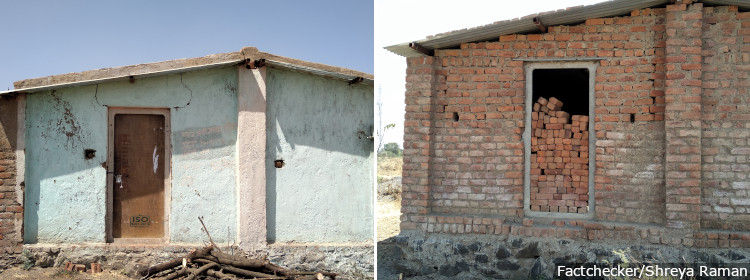
A house constructed under PMAY-G in Kochargaon village, Maharashtra, in 2017-18. The exterior is painted (left) but the back of the house (right) is incomplete. This house was declared “complete” on May 24, 2018.
“Everyone has got the Rs 120,000 under the scheme,” development officer Gaikwad said. “But only few have got the amount under SBM and MGNREGS. There has been no allocation under MGNREGS for 3-4 months now.”
While some families are borrowing to complete their houses, others are using up their life-savings to finish work. Bayda Gangode, 25, and her husband Devchandra are tomato farmers at Kochargaon village. They were named PMAY-G beneficiaries in August 2017 and within 10 months, they finished the construction of the house.
The house, which is painted in orange and yellow, has tiled floors and plywood doors. Gangode spent Rs 180,000, their life-savings, on the house in addition to the Rs 120,000. “We won’t build a house again so we wanted to do it right,” Gangode said, “We wouldn’t have been able to build a good house with only the government money.”
Every year, during tomato season, the landless couple take a farmland on rent to grow the tomatoes and earn up to Rs 30,000 as profit. This amount sustains the family of five through the year. The couple had saved up the Rs 180,000 in case the crop fails any year or for emergency. Now, with no safety net, Gangode says that she hopes the crop yields good profit this year.
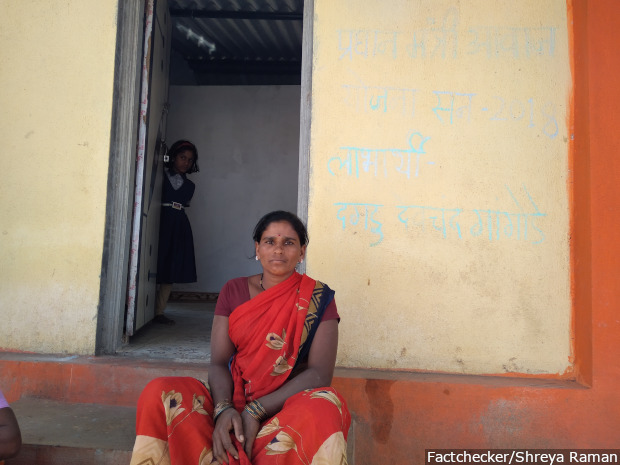
Bayda Gangode, 25, is a tomato farmer at Kochargaon village in Nashik, Maharashtra. She and her husband spent their life savings of Rs 180,000 to build a house under PMAY-G, the Prime Minister’s rural housing programme, in addition to a government subsidy of Rs 120,000.
A beneficiary who wants a loan is allowed one up to Rs 70,000, according to the PMAY-G. “A beneficiary would have the desire to construct his house as per his aspirations and future requirements as this would be a once in a lifetime activity,” said the scheme implementation document. None of the beneficiaries FactChecker spoke to were aware of these loans.
Number of houses built declining
The PMAY scheme, as we said, aims to provide housing for all by constructing 29.5 million houses by 2022, but the target is nowhere in sight.
In the three years since the programme began, the most houses were constructed in the first year, 3.45 million in 2016-17. The number has declined since--2.39 million in 2017-18 and 1.94 million in 2018-19. If the government aims to achieve its targets, it needs to complete 10.9 million houses over the next two years to 2022, a yearly target higher than that of the last three years.
This story is part of “Modi’s Report Card”, a series evaluating flagship government programmes in the run up to the 2019 general elections. You can read a set of stories on the rural jobs programme here, here and here; on the rural electrification programme here, here and here; on Swachh Bharat Mission here, here and here; the skills-development mission here; the crop-insurance scheme here; the project to bring broadband connectivity to every India village here; the project to clean up the Ganga river here; the cooking-gas programme here and the urban housing scheme here.
(Shreya Raman is a data analyst with IndiaSpend and FactChecker.)
We welcome feedback. Please write to respond@indiaspend.org. We reserve the right to edit responses for language and grammar.


